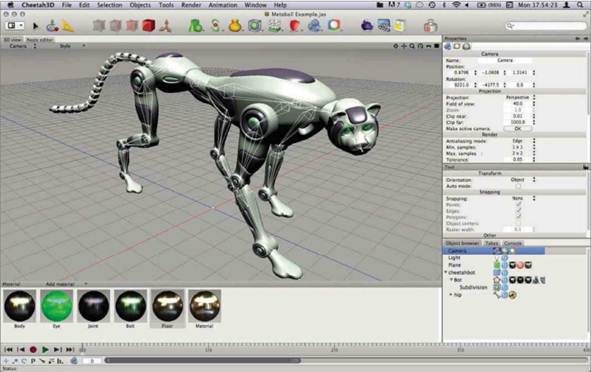Cheetah3D goes from strength to strength
with every new release. Version 5 introduced a sophisticated, node-based
materials system and optimisations to the ‘bucket’ renderer that were capable
of some startling render speedups. Now, more than two years later, version 6
brings several welcome new features, not the least of which is a price drop
from around $135 (sold in US dollars at $149) to an extremely reasonable $99,
putting it within reach of a much wider audience.

Skeleton
crew: Cheetah3D 6 implements a ‘bones’ system for creating joined armatures for
character animation. This system will be extensively overhauled in the few
releases
Certainly the biggest new feature is the
seamless integration of the industry-standard Bullet physics engine – more
about that later. First, though, we’ll get some of the minor players out of the
way. For modeling, version 6 now supports isosurfaces (metaballs), which allow
you to stretch a skin over several object types: spheres, vertices, splines and
particles. Drop a spline into an isosurface object and it gains thickness. Drag
multiple object and their skins blend and coalesce in the Editor window in real
time. The weight (thickness) and radius of the isosurface can be continuously
varied and animated for each individual object within an isosurface object,
giving you great flexibility in creating ofganic forms.
Alongside isosurfaces, there are three new
parametric entities: Capsule, Line and Fractal (actually a Sierpinski sponge
with four levels of subdivision). Three new modeling modifiers have also been
added; Smooth, Shell and Crumple. Finally, there’s improved Collada export,
which is necessary for iBooks compatibility. On the animation front, two new
paramenters – mesh points and spline controls points – gain the ability to be
keyframed, increasing overall level of fine control in aninations.
So, on to the main feature: dynamics.
Rather than try to re-invent the wheel, Cheetah3D’s author, Dr Martin
Wengenmayer, has chosen to integrate the fully featured, open-source Bullet
physics engine. Now, open source doesn’t mean second rate, since the Bullet
engine is also used in industry heavyweights such as Maya, Houdini, Light-Wave
and Softimage. It’s also used on the PalyStation 3 and supports optimisations
for OpenCL, the technology supported by OS X that allows programs to tap into
the power of modern graphics cards’ GPUs to significantly improve speed.

Reality
check: Cheetah’s render engine supports both HDRI and radiosity to produce
images of breathtaking reality, as shown by this interior render, as well as
more fantastic creations
Bullet’s implementation varies from
platform to platform, but Cheetah3D manages to tame it and make it wonderfully
simple to use. The dynamics implemented are split into two broad camps: Hard
Body and Soft Body.
Hard bodies are used when you want objects
to interact directly with each other, hitting each other, rebounding, falling
under gravity and so on. Setup of a hard body is simple: attach a Rigid Body
tag to an object, leave its type as the default dynamic and simply hit Play on
the animation controls. The object will then fall under gravity: there’s no
need to add an explicit gravity effector to the scene (although you can if you
want to). Now, place a second object (a plane, say) under your first object,
add a Rigid Body tag set to Static, press Play and your object will now fall
and bounce off, and around on, the plane. It can be that simple. There are, of
course, many parameters that you can tweak, among them mass, friction,
elasticity and damping to fine-tune these interactions.
Soft Body dynamics are just as easy to set
up, and are used for simulating cloth and softer, jelly-like objects. A flag
billowing in the breeze is simply a matter of pinning two end points of a
plane, adding the Soft Body tag to it, slapping in a wind effector and hitting
Play. That’s it. While there’s no dedicated fluid dynamics engine, the Soft
Body dynamics can go a long way to filling this role and, especially when
combined with the isosurfaces and particle systems, can produce convincing
blobby, splattery or gushing effects.
The addition of the dynamics system makes
Cheetah3D a compelling proposition for those starting out in 3D or even for
seasoned 3D artists who appreciate an uncluttered and intuitive program that
makes it easy to get on with what you want to do.
While it may lack some of the ultimate
animation control of the big apps costing hundreds or thousands more (although
this will be addressed in the next series of upgrades), and some rendering
features like sub-surface scattering and volumetric lighting still aren’t
implemented (although they can be simulated by the new materials system), Sheetah3D
6 covers all the bases with elegance and efficiency. This, combined with the
recent price drop, means it thoroughly deserves its five-mouse rating.
|
Details
|
|
Price
|
$90
|
|
Website
|
www.cheetah3d.com
|
|
Needs
|
Intel Mac * OS X 10.5
|
|
Pro
|
new, industry-standard Bullet physics
system * dynamics can be ‘baked’ to save calculation time * isosurface
(meatball) modeling tools render management * price drop
|
|
Con
|
nothing too serious
|
|
Rating
|
5/5
|